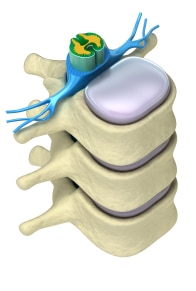Herniated Disc Treatment in San Antonio
A herniated disc occurs when one of the discs that cushion your vertebrae bulges out of its normal alignment

Herniated or bulging discs are known to cause pain and/or irritation, as they result in back bones not aligning properly.
The spinal discs are sometimes referred to as the shock absorbers of our spine.
They literally cushion the stress placed on our spine by providing a gap between the vertebrae. The disc consists of two parts. The center, referred to as the nucleus pulposis is comprised of a gelatinous matrix similar to jelly. The matrix is made of mostly water. The outer covering that keeps the nucleus intact is called the annulus fibrosis which is made of criss-crossing fibers. The disc itself consists of about 88% water, but as we age, the disc begins to lose water which flattens or thins the disc. This is known as disc degeneration.
Disc degeneration also occurs more rapidly after disc injury such as an annular tear. As the disc thins, more stress is placed on the joints behind the disc. More severely, the narrowing actually reduces the size of the opening where the exiting nerve roots extend from the spinal canal. The reduction in the size of the “nerve hole” creates irritation and causes an inflammatory process to ensue. The result is a myriad of effects that include inflammation of the nerve, inflammation of the surrounding tissue, muscle spasm and pain.
Request an Appointment
Please fill out the information below & someone from our team will contact you to confirm your visit.
Symptoms
Herniated discs most commonly occur in the lower back and the neck. Symptoms of a herniated disc include:
- Numbness or tingling. People affected by a herniated disc commonly report numbness close the affected area.
- Arm, buttock, or leg pain. Prolonged or shooting pain from your upper spine through your lower back and into your legs is a common symptom that you may have a herniated disc.
- Weak back. If you experience great difficulty lifting objects in your lower back, it can be a sign of a herniated disc.
The most common mechanism of injury to a disc is a compression of the disc coupled with a shearing motion or twisting.
This generally happens over a long period of time with age. It’s often impossible to trace the pain back to an original instance, as tiny injuries can accumulate over time into a larger injury..
When a disc is injured from overstress, like lifting a heavy object, the fibers of the annulus are torn which allow the nucleus to ooze from its center. This causes a bulging disc which can pinch the exiting spinal nerve or even the dural sac called the cauda equina.
Without proper treatment of the herniation or bulging, symptoms may worsen over time. Ultimately, herniated discs can cause extreme numbness, loss of touch sensations, and bowel dysfunction.
Some serious emergent conditions may require immediate medical care such as Cauda Equina Syndrome. Symptoms include loss of bowel or bladder control and numbness around the anal region. Other serious neurological symptoms include loss of balance, paralysis or foot drop.
Herniated or bulging discs are known to cause pain and/or irritation as they press inward on the spinal cord or adjacent nerve roots.
If you think you’re suffering from a herniated disc
If you’re currently experiencing any symptoms of a herniated disc, contact us today at 210-741-9166 and let one of our specialists help. Our team is specially trained in the diagnosis and treatment of disc herniations. With a significant disc herniation that is causing severe pain, treatments like epidural steroid injections can provide you quick relief. Treatments like spinal decompression therapy can help to address the root cause of the pain and help restore proper function to the disc.
